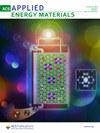作为高倍率锂原电池导电添加剂的碱激活纳米离子多孔空心碳
IF 5.4
3区 材料科学
Q2 CHEMISTRY, PHYSICAL
引用次数: 0
摘要
CFx 材料的共价 C-F 键含量较高,使得材料的导电性变差,电池极化现象严重,大大降低了功率密度并导致发热。因此,添加导电剂显得尤为重要,它能提高电极中电子迁移速度,抑制极化现象,促进活性物质的有效利用。本文采用室温碱性活化法制备了一种具有空心多孔结构的碳纳米离子(CNO),作为锂/CFx 电池的导电剂。多孔结构降低了锂离子的扩散阻力,有利于锂/CFx 电池获得更好的速率性能。电化学结果表明,碱活化的 CNO 作为正极材料的一部分可有效提高锂/CFx 电池的速率性能。与商业导电添加剂 SP 相比,在 2 C 放电速率下,CNO-NaOH-5M 的比容量和能量密度分别提高了 83.59% 和 144.63%。8 C 时,CNO-NaOH-3M 样品的功率密度和能量密度分别为 6907.36 和 863.42 Wh/kg,明显优于原始 CNO 和 SP。作为导电剂,碱活化 CNO 含氧官能团的增加提高了正极对电解液的不浸润性,孔隙空心结构的增加提高了界面接触面积,有利于放电过程中电子和锂离子的传输速度,从而使锂离子/CFx 电池具有高倍率性能。本文章由计算机程序翻译,如有差异,请以英文原文为准。

Porous Hollow Carbon Alkali-Activated Nanoonions As a Conductive Additive for High-Rate Lithium Primary Batteries
The high content of the covalent C–F bond of CFx materials makes the conductivity of the materials worse and the battery polarization serious, which greatly reduces power density and leads to heat generation. Therefore, adding a conductive agent is particularly important, as it improves the electron migration speed in the electrode, suppresses the polarization phenomenon, and promotes the effective use of active substances. In this paper, a carbon nanoonion (CNO) with a hollow porous structure is prepared by a room-temperature alkaline activation method as a conductive agent for the Li/CFx battery. The porous structures reduce the diffusion resistance of lithium ions, which is beneficial for Li/CFx batteries to achieve a better rate performance. The electrochemical results show that alkali-activated CNO as a part of the cathode material effectively improves the rate performance of the Li/CFx batteries. At the 2 C discharge rate, the specific capacity and energy density of CNO-NaOH-5M increased by 83.59% and 144.63%, respectively, compared with the commercial conductive additive SP. The power density and energy density of CNO-NaOH-3M samples at 8 C are 6907.36 and 863.42 Wh/kg, respectively, which was significantly better than the original CNO and SP. As a conductive agent, the increase of the oxygen-containing functional group of alkali-activated CNO improves the infiltrability of the cathode to the electrolyte, and the increase of pore-hollow structure improves the interface contact area, which is conducive to the transmission speed of electrons and lithium ions during discharge so that the Li/CFx battery has high rate performance.
求助全文
通过发布文献求助,成功后即可免费获取论文全文。
去求助
来源期刊

ACS Applied Energy Materials
Materials Science-Materials Chemistry
CiteScore
10.30
自引率
6.20%
发文量
1368
期刊介绍:
ACS Applied Energy Materials is an interdisciplinary journal publishing original research covering all aspects of materials, engineering, chemistry, physics and biology relevant to energy conversion and storage. The journal is devoted to reports of new and original experimental and theoretical research of an applied nature that integrate knowledge in the areas of materials, engineering, physics, bioscience, and chemistry into important energy applications.
 求助内容:
求助内容: 应助结果提醒方式:
应助结果提醒方式:


